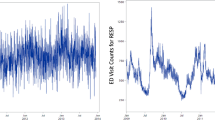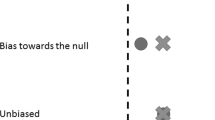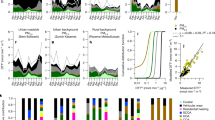Abstract
A crucial step in an epidemiological study of the effects of air pollution is to accurately quantify exposure of the population. In this paper, we investigate the sensitivity of the health effects estimates associated with short-term exposure to fine particulate matter with respect to three potential metrics for daily exposure: ambient monitor data, estimated values from a deterministic atmospheric chemistry model, and stochastic daily average human exposure simulation output. Each of these metrics has strengths and weaknesses when estimating the association between daily changes in ambient exposure to fine particulate matter and daily emergency hospital admissions. Monitor data is readily available, but is incomplete over space and time. The atmospheric chemistry model output is spatially and temporally complete but may be less accurate than monitor data. The stochastic human exposure estimates account for human activity patterns and variability in pollutant concentration across microenvironments, but requires extensive input information and computation time. To compare these metrics, we consider a case study of the association between fine particulate matter and emergency hospital admissions for respiratory cases for the Medicare population across three counties in New York. Of particular interest is to quantify the impact and/or benefit to using the stochastic human exposure output to measure ambient exposure to fine particulate matter. Results indicate that the stochastic human exposure simulation output indicates approximately the same increase in the relative risk associated with emergency admissions as using a chemistry model or monitoring data as exposure metrics. However, the stochastic human exposure simulation output and the atmospheric chemistry model both bring additional information, which helps to reduce the uncertainly in our estimated risk.
This is a preview of subscription content, access via your institution
Access options
Subscribe to this journal
Receive 6 print issues and online access
$259.00 per year
only $43.17 per issue
Buy this article
- Purchase on Springer Link
- Instant access to full article PDF
Prices may be subject to local taxes which are calculated during checkout







Similar content being viewed by others
References
Dominici F, Peng RD, Bell ML . Fine particulate air pollution and hospital ad- mission for cardiovascular and respiratory diseases. J Am Med Assoc 2006; 10: 1127–1134.
Pope CA, III, Dockery DW . Health effects of fine particulate air pollution: lines that connect. J Air Waste Manag Assoc 2006; 561: 709–742.
Bell M, Ebisu K, Dominici F, Peng R . Adverse health effects of particulate air pollution: modification by air conditioning. Epidemiology 2009; 20: 682–686.
Ostro B, Roth L, Malig B, Marty M . The effects of fine particle components on respiratory hospital admissions in children. Environ Health Perspect 2009; 53: 475–480.
Ostro BD, Broadwin R, Lipsett MJ . Coarse and fine particles and daily mortality in the Coachella valley: a follow-up study. J Expo Anal Environ Epidemiol 2000; 10: 412–419.
Braga ALF, Zanobetti A, Schwartz J . The lag structure between particulate air pollution and respiratory and cardiovascular deaths in ten US cities. J Occup Environ Med 2001; 12: 927–933.
Holloman CH, Bortnick SM, Morara M, Strauss WJ, Calder CA . A Bayesian hierarchical approach for relating PM2.5 exposure to cardiovascular mortality in North Carolina. Environ Health Perspect 2004; 112: 1282–1288.
Hoek G, Brunekreef B, Fisher P, Wijnen JV . The association between air pollution and heart failure, arrythmia, embolism, thromobosis, and other cardiovascular causes of death in a time series study. Epidemiology 2001; 66: 355–357.
Pope CA, Dockery DW, Schwartz J . Review of epidemiological evidence of health-effects of particulate air-pollution. Inhal Toxicol 1995; 7: 1–18.
Dockery DW, Pope CA, Xu X, Spengler JD, Ware JH, Fay ME et al. An association between air pollution and mortality in six US cities. N Engl J Med 1993; 329: 1753–1759.
Dockery D, Pope CA . Acute respiratory effects of particulate air pollution. Annu Rev Public Health 1994; 15: 107–132.
Fuentes M, Song H-R, Ghosh SK, Holland DM, Davis JM . Spatial association between speciated fine particles and mortality. Biometrics 2006; 62: 855–863.
Samet JM, Zeger SL, Dominici F, Curriero F, Coursac I, Dockery D et al The National Morbidity, Mortality, and Air Pollution Study (HEI Project No. 96-7): Morbidity and Mortality from Air Pollution in the United States. Health Effects Institute: Cambridge, MA, USA. 2000.
Byun DJ, Schere KL . Review of the governing equations, computational algorithms, and other components of the models-3 community multiscale air quality (cmaq) modeling system. Appl Mech Rev 2006; 59: 51–77.
Calder CA, Holloman CH, Bortnick SM, Strauss WJ, Morara M . Relating ambient particulate matter concentration levels to mortality using an exposure simulator. J Am Stat Assoc 2008; 112: 137–148.
Berrocal VJ, Gelfand AE, Holland DM, Burke J, Miranda ML . On the use of a PM2.5 exposure simulator to explain birthweight. Environmetrics 2011; 22: 553–571.
Blangiardo M, Hansell A, Richardson S . A bayesian model of time activity data to investigate health effect of air pollution in time series studies. Atmos Environ 2011; 45: 379–386.
Reich BJ, Fuentes M, Burke J . Analysis of the effects of ultrafine particulate matter while accounting for human exposure. Environmetrics 2009; 20: 131–146.
The New York City Community Air Survey available at http://www.ebookbrowse.com/ pr-538-nyccas-report-pdf-d31505400l 2009.
Peng RD, Chang HH, Bell ML, McDermott A, Seger SL, Samet JM et al. Coarse particulate matter air pollution and hospital admissions for cardiovascular and respiratory diseases among medicare patients. J Am Med Assoc 2008; 299: 2172–2179.
Binkowski FS, Roselle SJ . Models-3 community multiscale air quality (CMAQ) model aerosol component, 1. Model description. J Geophys Res 2003; 108.
Fuentes M, Raftery A . Model evaluation and spatial interpolation by bayesian combination of observations with outputs from numerical models. Biometrics 2005; 66: 36–45.
Chang HH, Reich BJ, Miranda ML . Time-to-event analysis of fine particle air pollution and preterm birth: results from North Carolina, 2001-2005. Am J Epidemiol 2012; 175: 91–98.
Bravo MA, Fuentes M, Zhang Y, Burr MJ, Bell ML . Comparison of exposure estimation methods for air pollutants: ambient monitoring data and regional air quality simulation. Environ Res 2012; 121: 1–10.
Burke JM, Vedamtham R . Stochastic Human Exposure And Dose Simulation For Particulate Matter (Shed-Pm) Version 3.5 User Guide. US Environmental Protection Agency. 2009.
Jones R, Özkaynak H, Nayak S, Garcia V, Hwang S-A, Linn S . Associations between summertime ambient pollutants and respiratory morbidity in NYC: comparison of ambient concentrations versus predicted exposures. J Expo Sci Environ Epidemiol, in press.
Frey CH, Jiao W, Cao Y . Assessment of inter-individual, geographic, and seasonal variability in estimated human exposure to fine particulate matter. Environ Sci Technol 2012; 46: 12519–12526.
Cao Y, Frey HC . Assessment of interindividual and geographic variability in human exposure to fine particulate matter in environmental tobacco smoke. Risk Analysis 2010; 31: 578–591.
Cao Y, Frey HC . Geographic differences in inter-individual variability of human exposure to fine particulate matter. Atmos Environ 2011; 45: 5684–5691.
Dominici F, Zeger SL, Samet JM . A measurement error model for time-series studies of air pollution and mortality. Biostatistics 2000; 1: 157–175.
Dominici F . Invited commentary: air pollution and health- what can we learn from a hierarchical approach? Am J Epidemiol 2002; 155: 11–15.
Peng RD, Louis TA, Dominici F . Model choice in time series studies of air pollution and mortality. J R Stat Soc 2006; 169: 179–203.
Schwartz J . Nonparametric smoothing in the analysis of air pollution and respiratory illness. Can J Statist 1994; 22: 471–488.
Choi J, Fuentes M, Reich BJ . Spatial-temporal association between fine particulate matter and daily mortality. Comput Stat Data Anal 2009; 3: 2989–3000.
Berger JO . Statistical Decision Theory and Bayesian Analysis. Springer–Verlag: New York, NY, USA. 1985.
R Core Team. R: A Language and Environment for Statistical Computing. R Foundation for Statistical Computing: Vienna, Austria. 2012.
Özkaynak H, Frey HC, Burke J, Pinder RW . Analysis of coupled model uncertainties in source to dose modeling of human exposures to ambient air pollution: a PM2.5 case-study. Atmos Environ 2009; 43: 1641–1649.
Sarnat R, Wilson W, Strand M, Brook J, Wyzga R, Lumley T . Panel discussion review: session one exposure assessment and related errors in air pollution epidemiologic studies. JESEE 2007; 17: S75–82.
Tesche TW, Morris R, Tonnesen G, McNally D, Boylan J, Brewer P . CMAQ/CAMx annual 2002 performance evaluation over the eastern US. Atmos Environ 2006; 40.
Szpiro A, Paciorek C . Measurement error in two-stage analyses, with application to air pollution epidemiology. arXiv.org 2012.
Carroll RJ, Ruppert D, Stefanski LA, Crainiceanu CM . Measurement Error in Nonlinear Models: A Modern Perspective 2nd edn. Chapman & Hall/CRC, : Boca Raton, FL 2006.
Acknowledgements
We acknowledge Howard Chang at Emory University and Laura Boehm at North Carolina State University for their contributions in modeling methodology and data management. We also acknowledge Drs. Valeria Garcia and Halûk Özkaynak with the US Environmental Protection Agency’s National Exposure Research Laboratory, for providing the CMAQ output data and for guidance with the application of the SHEDS-PM model for New York City, respectively. Elizabeth Mannshardt was supported as a Post Doctoral Research Scholar through the National Science Foundation’s Collaborative Research: RNMS Statistical Methods for Atmospheric and Oceanic Sciences under Grant No. DMS-1107046. Katarina Sucic was supported in part by Harvard University’s Statistical Methods for Population Health Research on Chemical Mixtures, Grant No. 114346-5053742. Montserrat Fuentes was sponsored in part by the National Institutes of Health under Grant No. 2R01ES014843-04A1. Francesca Dominici was supported in part by the National Institutes for Health (NIH), Grant No. R01ES019560, NIH/National Institute of Environmental Health Sciences, Grant No. R01ES019955, and the Environmental Protection Agency, Grants No. RD83479801 and No. R834894. H. Christopher Frey and Wan Jiao were sponsored by the National RD 83386301.
Disclaimer
This paper has not been subject to review by the NSF, NIH or EPA, and the authors are solely responsible for its content.
Author information
Authors and Affiliations
Corresponding author
Ethics declarations
Competing interests
The authors declare no conflict of interest.
Rights and permissions
About this article
Cite this article
Mannshardt, E., Sucic, K., Jiao, W. et al. Comparing exposure metrics for the effects of fine particulate matter on emergency hospital admissions. J Expo Sci Environ Epidemiol 23, 627–636 (2013). https://doi.org/10.1038/jes.2013.39
Received:
Accepted:
Published:
Issue Date:
DOI: https://doi.org/10.1038/jes.2013.39
Keywords
This article is cited by
-
Monitoring vs. modeled exposure data in time-series studies of ambient air pollution and acute health outcomes
Journal of Exposure Science & Environmental Epidemiology (2022)
-
A framework for estimating the US mortality burden of fine particulate matter exposure attributable to indoor and outdoor microenvironments
Journal of Exposure Science & Environmental Epidemiology (2020)
-
Probabilistic estimation of residential air exchange rates for population-based human exposure modeling
Journal of Exposure Science & Environmental Epidemiology (2017)
-
Recent Approaches to Estimate Associations Between Source-Specific Air Pollution and Health
Current Environmental Health Reports (2017)
-
The importance of the exposure metric in air pollution epidemiology studies: When does it matter, and why?
Air Quality, Atmosphere & Health (2016)



